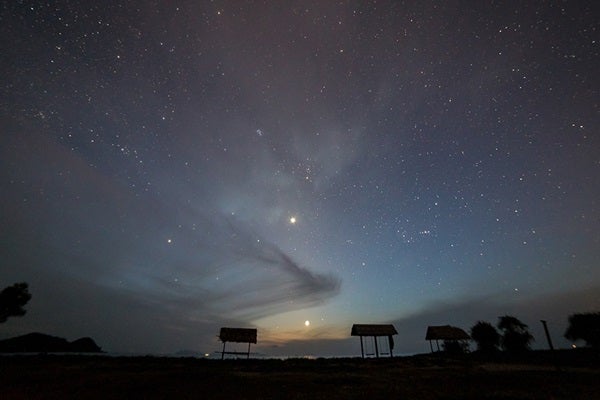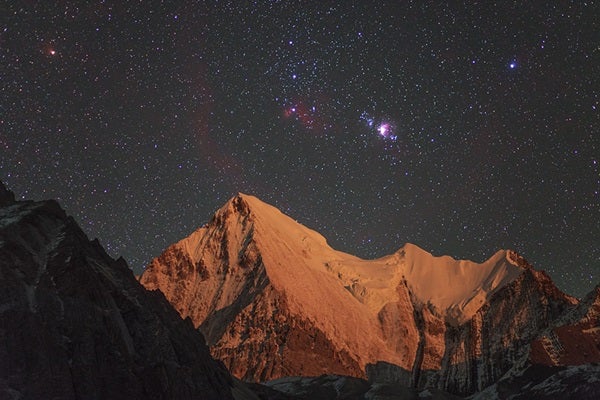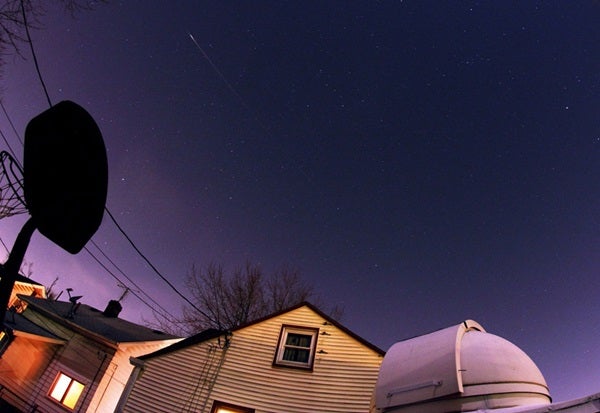Mars continues to put on a nice show in late December. Look for the Red Planet halfway to the zenith in the southern sky as darkness falls. The world shines at magnitude 0.4 against the much dimmer stars of Aquarius the Water-bearer. A telescope reveals a disk that spans 8″ and should show a few subtle surface features during moments of good seeing.
Saturday, December 29
Last Quarter Moon occurs at 4:34 a.m. EST. You will see it poking above the eastern horizon around midnight local time and climbing highest in the south as twilight starts to paint the sky. The halflit Moon spends the morning hours in the constellation Virgo the Maiden.
Sunday, December 30
For those who recently caught the observing bug, the so-called Summer Triangle must seem like a huge misnomer. That’s because this asterism remains on view after darkness falls in late December. Look for Vega, the fifth-brightest star in the sky and the brightest triangle member, in the northwest after nightfall. Deneb lies above Vega and about halfway to the zenith. Deneb marks the top of another asterism, the Northern Cross, which stands nearly straight up from the horizon on December evenings. Altair, the third triangle member, appears due west and at the same altitude as Vega. The trio remains on view until Altair sets just before 8 p.m. local time.
The setting Moon casts its light on the sacred Chana Dorje peak at Yading National Reserve in the Sichuan province of China. In the background sky, you can see the three belt stars of Orion lined up almost vertically above the pyramid-shaped peak. The Horsehead Nebula (B33) is visible near the belt stars, and to the right is the great Orion Nebula (M42). The red, glowing circular structure surrounding Orion is Barnard’s Loop. Copper-colored Betelgeuse (Alpha Orionis) and blue Rigel (Beta Orionis) appear on the left and right sides, respectively.
As the old year winds down to a precious few hours and winter tightens its grip on the Northern Hemisphere, one of the most familiar constellations takes center stage. Orion the Hunter appears conspicuous in the eastern sky as twilight fades and grows even more prominent after darkness settles in. The star group climbs highest in the south around 11 p.m. local time, when it stands about halfway to the zenith from mid-northern latitudes.
Tuesday, January 1
New Year’s Day dawns in spectacular fashion, with a waning crescent Moon and three bright planets arrayed above the southeastern horizon. The Moon rises first, just after 3 a.m. local time, with Venus following a half-hour later. Five degrees separate the night sky’s two brightest objects. Jupiter comes up about 90 minutes after Venus and Mercury trails an hour later. A half-hour before sunup, the four solar system objects stretch out across 35° of sky. Venus appears nearly 30° high and shines at magnitude –4.6; Jupiter is 15° high and glows at magnitude –1.8; and magnitude –0.4 Mercury stands 5° high in the brightening twilight. You also might catch a glimpse of the 1st-magnitude star Antares 5° to Jupiter’s lower right.
Wednesday, January 2
Earth reaches perihelion, the closest point to the Sun during its year-long orbit, at midnight EST. The two then lie 91.4 million miles (147.1 million kilometers) apart. It surprises many people to learn that Earth comes closest to the Sun in the dead of winter, but the cold weather in the Northern Hemisphere at this time of year arises because the Sun lies low in the sky.
Saturn passes behind the Sun from our perspective, a configuration astronomers call solar conjunction, at 1 a.m. EST. Needless to say, our star’s glare makes it impossible to see the planet. Saturn will return to view before dawn in the second half of January.
The Quadrantid meteor shower reaches its peak tonight. And with New Moon arriving in just two days, observers with clear weather will have ideal conditions. Astronomers expect the shower to peak around 9 p.m. EST. Unfortunately, the radiant — the point in the northern part of the constellation Boötes from which the meteors appear to originate — doesn’t climb high until the early morning hours. And rates drop dramatically from the peak. The Quadrantids can produce up to 120 meteors per hour at maximum, but that number drops to 30 just eight hours on either side. North American observers should see a good display, but the best views likely will come from Europe.
The waning crescent Moon appears 4° to the left of Jupiter this morning. Both objects rise shortly after 5 a.m. local time and climb about 10° high an hour before sunup. A telescope shows Jupiter’s 32″-diameter disk, but you likely won’t see much detail because the light has to travel through thick layers of turbulent air near the horizon.
Friday, January 4
Although people in the Northern Hemisphere experienced the shortest day of the year two weeks ago (at the winter solstice December 21), the Sun has continued to rise slightly later with each passing day. That trend stops this morning for those at 40° north latitude. Tomorrow’s sunrise will arrive at the same time as today’s, but the Sun will come up two seconds earlier Sunday morning. This turnover point depends on latitude. If you live farther north, the switch occurred a few days ago; closer to the equator, the change won’t happen until later in January.
Saturday, January 5
New Moon occurs at 8:28 p.m. EST. At its New phase, the Moon crosses the sky with the Sun and so remains hidden in our star’s glare. At least, it typically does. But if you live in the right area, you can watch the Moon pass in front of the Sun and cause a partial solar eclipse. Observers in southwestern Alaska, Japan, and eastern Asia can see the Moon partially eclipse the Sun. Maximum eclipse occurs in eastern Siberia, where our satellite covers 71 percent of the Sun’s disk. Remember that when viewing the Sun during a partial eclipse, protect your eyes by using a safe solar filter.
Sunday, January 6
Venus appears brilliant in the southeast before dawn. It reached greatest elongation late yesterday evening, when it was 47° west of the Sun, so it stands highest in this morning’s sky. The inner world shines at magnitude –4.6, more than 10 times brighter than the second-brightest planet, Jupiter. Venus rises nearly four hours before the Sun and stands 20° high in the southeast when twilight begins. The planet lies among the background stars of Libra, but it will move into Scorpius this coming week. If you point a telescope at Venus, you’ll see a disk that spans 25″ and appears halflit.












